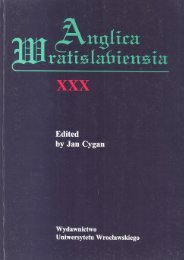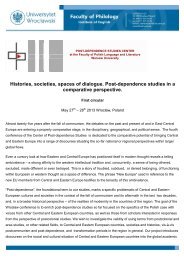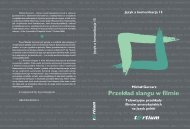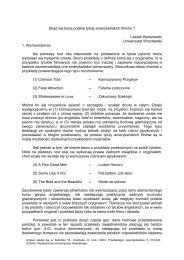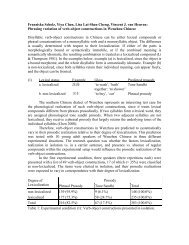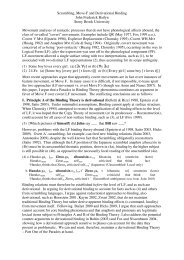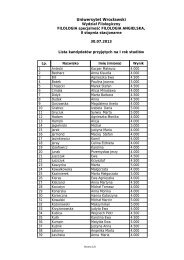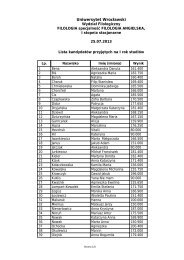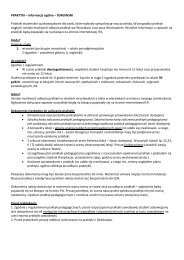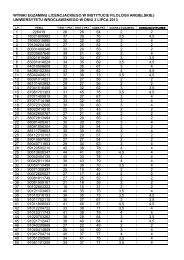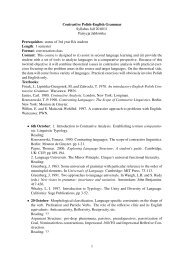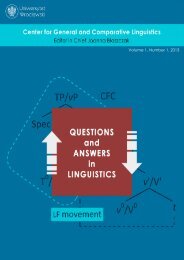Academic Journal Modern Philology
Academic Journal Modern Philology
Academic Journal Modern Philology
Create successful ePaper yourself
Turn your PDF publications into a flip-book with our unique Google optimized e-Paper software.
Language contact in New Zealand<br />
different levels. The strong influence of English on Māori is a direct result of the fact that Māori has been<br />
in contact with the dominant language, English, for over two centuries and it is also the consequence<br />
of the fact that virtually all native speakers of Māori were inevitably forced to become bilingual. As<br />
noted in the literature, the effects of the English dominance on Māori are visible, even though only little<br />
systematic research has been carried out so far. Due to the influence of English, Māori has been subject<br />
to phonological, grammatical and lexical changes. Māori vowel sounds, syllables and rhythm have been<br />
affected by English (Harlow et al. 2009). Furthermore, changes have been observed that involve Māori<br />
word order and transfers from English constructions (Harlow 2001). The presence of a large number of<br />
English borrowings in Māori has also been pointed out (Duval 1995).<br />
In contrast to this, the second scenario, that of contact as addition, defines the influence of<br />
a minority language, Māori, on a majority language, English. In this case, the impact on the receptor<br />
language, English, is rather limited, being restricted to some lexical borrowing. This influence has been<br />
noted in a number of studies investigating the presence and use of Māori lexical borrowings in New<br />
Zealand English (cf. Bellett 1995; Deverson 1985, 1991; Degani 2009, 2010; Kennedy 2001; Kennedy<br />
and Yamazaki 2000; Macalister 1999, 2000, 2004). Findings from these studies have also established a<br />
general tendency for Māori borrowings to relate to the semantic fields of native flora and fauna, proper<br />
names and places names, and cultural key concepts. Another language contact phenomenon that has<br />
been researched is the creation of hybrid compounds that merge Māori and English elements (Degani<br />
& Onysko 2010). Indeed, Māori loans and hybrid compounds can be seen as the most distinctive traits<br />
of New Zealand English lexis. They unquestionably mark the uniqueness of New Zealand English as a<br />
variety of English. In addition to these studies, Macalister (2005) has compiled A Dictionary of Maori<br />
Words in New Zealand English in which he records about 900 Māori borrowings. Interestingly enough,<br />
when Macalister did a follow-up study (2006) testing New Zealanders’ actual knowledge of Māori loans,<br />
he found out that only about 10% of these terms are known by the average New Zealander. To sum up,<br />
while the influence of Maori on English has remained on the lexical level, this influence has generated a<br />
substantial amount of research.<br />
15<br />
3. Lexical borrowing: the Māori perspective<br />
If we now take the perspective of Māori and focus on the lexical level, it is striking to observe that the<br />
situation is quite the opposite than the one just described for English. As noted by Harlow (2004), the<br />
impact of English on Māori still remains to be accounted for to a large extent. This is even more so the case<br />
with English lexical influence on Māori. To date, the major study of borrowing in Māori remains Duval’s<br />
thesis (1995), which identified over 2500 distinct items looking at more than 300 publications from 1815<br />
to 1899, that is in the early phase of contact. The range of borrowed terms that Duval identified includes<br />
loans from English, French and Latin, and most of them pertain to Christianity, technology, trade and law.<br />
These reflect the new ideas and concepts that were introduced by the European missionaries and settlers.<br />
However, as Harlow observes (2004: 149–150), there are problems associated with the sources on which<br />
Duval relied for his study, namely word lists and texts of mostly missionary origin. On the one hand, word<br />
lists are likely to underrepresent the extent and type of lexical borrowings in use at that time because they<br />
were compiled with the aim to represent indigenous vocabulary. On the other hand, texts of missionary



